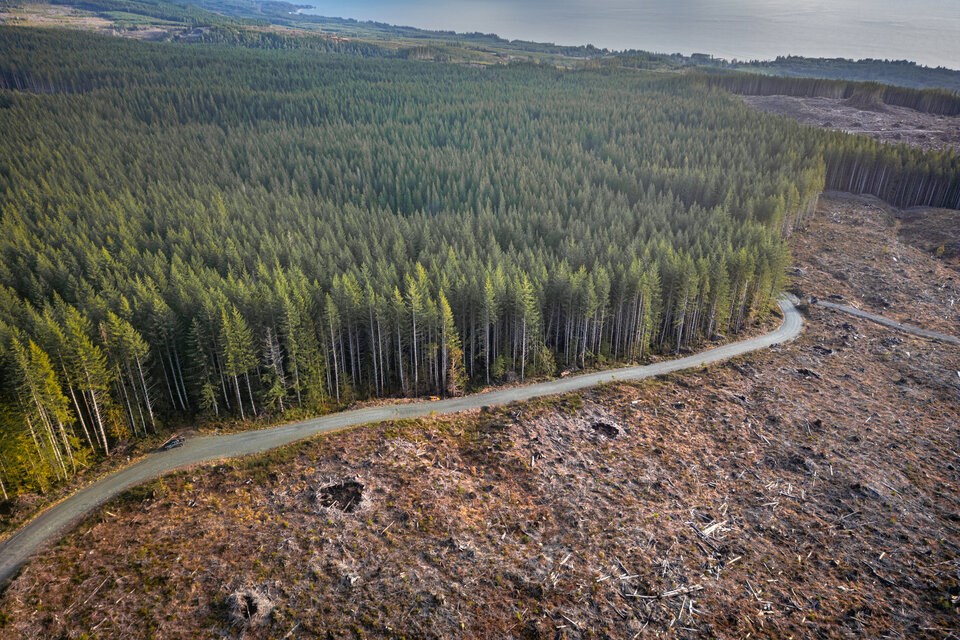The NDP’s federal environment critic says sa国际传媒 is ignoring calls to close loopholes in how it reports carbon emissions from logging — what some experts suggest could amount to 90 million tonnes a year.
A March 2023 from Commissioner of the Environment and Sustainable Development Jerry DeMarco found the federal government had failed to properly account for emissions from the country’s forestry sector. Among several recommendations, DeMarco — who serves under the Office of the Auditor General of sa国际传媒 — said the federal government “did not provide a clear and complete picture” of greenhouse gases from forestry and called for an independent expert review to assess any gaps.
A year later, Laurel Collins, NDP member of Parliament for Victoria and the party’s environment and climate change critic, said the government's response has been to take a “really narrow review” of how it counts forestry emissions at the same time sa国际传媒 experienced its worst wildfire season in recorded history.
“If we continue to lie to ourselves about our forestry emissions, we don't have a hope of getting better,” said Collins. “We don't have a hope of making this right.”
Government plan fails to address audit's key recommendations
In December 2023, a government document circulated to stakeholders and later reviewed by Glacier Media outlined three options on how Ottawa could change its emission auditing process.
The options all focus on sa国际传媒's baseline for assessing emission reductions. None of the options mention an external review and none address how sa国际传媒 might close its emissions reporting gap.
Evidence suggests that gap could be huge. Between 2005 and 2021, the country's national emissions inventory report said forests in sa国际传媒 absorbed just shy of five million tonnes a year, making it a small carbon sink.
But in published in the peer-reviewed journal in January, experts found the government failed to account for nearly a 100 million tonnes of forest carbon emissions. That would put logging emissions on par with sa国际传媒’s electricity sector.
The discrepancy in emissions data comes from the way the government reports wildfire emissions, say experts.
Carbon pollution from wildfires is not counted because it’s considered “natural.” But once forests grow back — reaching commercial maturity at 76 years old — the government inventory starts to count all the carbon those trees suck out of the atmosphere, even though they were never re-planted after logging, explained Jay Malcolm, a study co-author and professor emeritus at the University of Toronto’s Faculty of Forestry.
“That is the entire difference,” Malcolm said at the time. “It's kind of a shell game.”
In the end, the researchers found total area logged was a “significant predictor of net forestry emissions.”
Emissions accounting 'painting a rosier picture for sa国际传媒'
Last month, Collins cited the peer-reviewed study in a letter to Prime Minister Justin Trudeau in which she slammed the government for failing to follow through on the commissioner’s key recommendations and ignoring calls to fix how it reports logging emissions.
The accounting flaws, wrote the NDP critic, inaccurately portray the forestry sector as a net-zero emitter. That “justifies high-emission harvesting activities,” raises questions about transparency and objectivity, and “calls into question the legitimacy and efficacy of the review process.”
Should the annual gap in forestry carbon emissions turn out to be accurate, the industry’s average historical annual emissions would skyrocket to roughly 90 million tonnes, officially making it a carbon emitter.

By maintaining the status quo and portraying the logging sector as an industry that absorbs as many emissions as it releases, Collins told Trudeau companies are unduly given an advantage over other sectors when it comes to things like carbon pricing.
“The difficulty is that if we don't do this, it means that we actually can't make the policy changes needed to reduce our emissions,” Collins said.
“And it also means we’re painting a rosier picture for sa国际传媒 [and] whether or not we're meeting our climate targets.”
Glacier Media asked how the federal government accounted for the missing 90 million tonnes of forestry emissions identified by outside experts. In an unattributed statement sent two weeks later, a spokesperson for Natural Resources sa国际传媒 said its method for reporting emissions from Canadian forests is informed by “science- and evidence-based best practices and international standards.”
The statement read: “…the Government of sa国际传媒 remains committed to science-based best practices, and continuous improvement and review of techniques to ensure accuracy and accordance with international standards and leadership.”
Government 'addressing all recommendations'
Collins said she has not yet heard back from the prime minister, Environment and Climate Change sa国际传媒 or Natural Resources sa国际传媒.
Michael Polanyi, a policy and campaign manager for Nature sa国际传媒, said the group doesn’t expect government to change its policy based on a single scientific paper. In this case, however, the research published in January is just the latest in a growing body of evidence that emissions accounting is “masking” the true extent of greenhouse gas emissions from industrial logging.
“We expect them to take it seriously and take a more in-depth look at the what’s going on,” he said.
“The commissioner was pretty clear.”
When asked about the status of the independent expert review recommended by commissioner Demarco, a government spokesperson said both National Resources sa国际传媒 and Environment and Climate Change sa国际传媒 are “addressing all recommendations” from his office and that “a number of scientific consultations and reviews” are being carried out.
That includes a detailed technical review by United Nations Framework Convention on Climate Change (UNFCCC) secretariat experts. Completed in 2023 and set to be published this spring, the technical review will help improve interdepartmental planning, said the statement.




